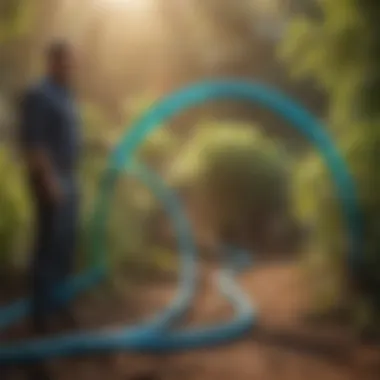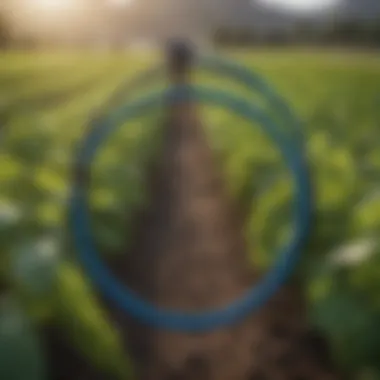Exploring Bluetooth Hose Technology: A Comprehensive Insight


Intro
The advent of technology in agriculture has led to innovative solutions that can optimize efficiency and sustainability within farming practices. Among these innovations, Bluetooth hose technology presents a remarkable advancement. This article will explore various aspects of Bluetooth hoses, including their functionality, integration with other smart systems, and practical applications in agriculture and horticulture. Understanding this technology is crucial for farmers and enthusiasts who seek to enhance irrigation and fluid delivery systems.
Latest Trends in Agriculture
Overview of Current Trends
In the contemporary agricultural landscape, several key trends are shaping how farming is conducted. Precision farming, which relies on data analysis and technology, has become increasingly common. Bluetooth hose systems are an integral part of this trend, providing farmers with precise control over irrigation. This technology allows for remote monitoring and adjustments, ensuring that crops receive the right amount of water at the right time.
Impact of Technology on Farming Practices
The integration of technology in farming has transformed traditional practices. Farmers now utilize sensors and automated systems that increase efficiency and reduce waste. Bluetooth hoses exemplify this shift. They can be integrated with weather data and soil moisture sensors, facilitating adaptive irrigation strategies. This not only conserves water but also optimizes crop yields.
"The implementation of smart irrigation systems can improve water use efficiency by up to 50%."
Sustainable Practices: Towards a Greener Future
Importance of Sustainability in Agriculture
Sustainability is a fundamental principle in modern agriculture. The growing concern about climate change and environmental degradation has led to a shift towards more sustainable farming practices. Farmers are increasingly aware of their ecological footprint and the importance of conserving natural resources.
Methods for Sustainable Farming
Several methods contribute to sustainable agriculture. Crop rotation, cover cropping, and reduced tillage are popular practices. Bluetooth hoses play a role in this by enabling precise water management. Technology helps reduce reliance on chemical fertilizers and pesticides, promoting healthier ecosystems.
Gardening Techniques and Tips
Essential Gardening Tools and Equipment
For horticulturists, having the right tools is essential. Quality shovels, pruners, and soil testers are fundamental. Aside from physical tools, integrating Bluetooth-connected hoses can improve irrigation practices, making gardening more efficient.
Seasonal Gardening Practices
Understanding seasonal changes is key to successful gardening. Different plants thrive in specific conditions. By using Bluetooth hoses, gardeners can adapt to changing weather patterns more readily, ensuring they provide optimal hydration for their plants throughout the seasons.
In summary, exploring Bluetooth hose technology reveals its potential impact on both agriculture and horticulture. As technological advancements continue, the importance of effective irrigation systems cannot be overstated.
Prelude to Bluetooth Hose Technology
Bluetooth hose technology represents an innovative fusion of traditional hose systems with modern wireless communication capabilities. This integration serves both the agricultural sector and horticulture, resulting in improved efficiency and performance. As the demand for sustainable farming practices continues to grow, understanding Bluetooth hoses becomes essential. Farmers and agricultural enthusiasts can leverage this technology to improve irrigation processes and fluid delivery systems, thereby enhancing their productivity.
Definition of Bluetooth Hose
A Bluetooth hose is a flexible tube embedded with Bluetooth technology that allows for wireless communication to manage various functions related to fluid transport and irrigation systems. This technology enables real-time monitoring and control, as users can connect their smartphones or other devices to receive data and adjust settings as necessary. Such capabilities represent a significant advancement over traditional hoses, which lack the ability to relay information back to the user. In essence, Bluetooth hoses provide greater automation and responsiveness in managing water resources.
Historical Development of Hose Technology
The progression of hose technology dates back centuries, initially focusing on basic materials like leather and rubber. Over time, advancements in materials science have led to enhanced durability and flexibility. The introduction of synthetic materials further contributed to this evolution. However, the significant leap came with the advent of digital technology. The merging of hose systems with Bluetooth technology began gaining traction in the early 21st century. Researchers started exploring how wireless communication could simplify agricultural practices and improve resource management.
Ultimately, the development of Bluetooth hoses highlights an important shift in agricultural technology. In recent years, these systems have begun to see wider adoption, particularly in regions where water scarcity is a pressing issue. Understanding this historical context is crucial for comprehending the current landscape of Bluetooth hose technology and its potential implications for the future of agriculture.
Understanding Bluetooth Connectivity
Bluetooth connectivity serves as the backbone of Bluetooth hose technology. Understanding its fundamental principles is crucial for grasping how these hoses function effectively in agricultural practices. This section will explore the basic concepts of Bluetooth technology as well as its practical applications in hose systems.
Basics of Bluetooth Technology


Bluetooth is a wireless communication standard that facilitates short-range connectivity between devices. It operates on the 2.4 GHz frequency band, which is the same frequency used by many household devices. Understanding how Bluetooth works helps in managing data transmission effectively.
Key characteristics of Bluetooth technology include:
- Low Energy Consumption: Bluetooth is designed to use minimal power, which is essential for devices powered by batteries.
- Interoperability: Various devices can communicate with one another, making it versatile for different applications, including hoses.
- Security Features: Encryption protocols improve safety in data exchange, important for sensitive agricultural data.
The ability to connect multiple devices without physical wiring makes Bluetooth essential in agricultural settings. Farmers can use Bluetooth-enabled devices for monitoring and controlling operations seamlessly.
How Bluetooth Works in Hose Applications
Understanding how Bluetooth works in hose applications requires knowledge of its integration into device management systems. In these systems, Bluetooth hoses collect and transmit data related to irrigation and fluid delivery.
The operation of Bluetooth in hose applications can be broken down into several steps:
- Data Gathering: Sensors placed within the hose collect information on water flow, pressure, and moisture levels.
- Signal Transmission: The collected data is wirelessly transmitted to a central hub or farmers' smartphones. This allows for real-time analysis and action.
- Response Mechanisms: Upon analyzing the data, users can trigger changes in the irrigation process, such as adjusting flow rates or scheduling watering times.
This use of Bluetooth technology enhances efficiency and reduces waste. Farmers can make informed choices, adapting their practices based on real-time data.
"Bluetooth technology not only enhances communication between devices but also optimizes agricultural processes and resources."
Bluetooth connectivity in hoses represents an innovative leap in modern agriculture. Its strengths lie in its simplicity, energy efficiency, and its ability to connect various devices seamlessly. Overall, a solid understanding of this connectivity is vital for the successful integration of Bluetooth hoses into farming operations.
Components of Bluetooth Hoses
Understanding the components of Bluetooth hoses is essential for appreciating their functionality and advantages in agricultural applications. These hoses blend traditional irrigation and delivery systems with advanced wireless technologies, making it crucial to delve into their specific elements, benefits, and considerations.
Material Composition
Bluetooth hoses are made from materials that ensure durability and performance under various conditions. Key materials include thermoplastic polyurethane, rubber, and nylon. These materials provide flexibility and resistance to weathering, abrasion, and chemicals. Such durability is vital in agriculture, where hoses are exposed to sunlight, dirt, and moisture.
Through careful selection of material, manufacturers can produce hoses that resist wear and tear. This translates into lower maintenance costs and longer lifespan, making them an economically sound choice for farmers. Additionally, the lightweight nature of these materials allows for easier handling and installation.
Sensor Integration
Sensor integration plays a significant role in the functionality of Bluetooth hoses. These sensors can monitor various parameters such as moisture levels, temperature, and pressure. By capturing real-time data, sensors enable farmers to make informed decisions about irrigation schedules and fluid delivery.
The integration of sensors leads to enhanced precision in irrigation practices. For example, moisture sensors detect when the soil reaches a certain dryness level, triggering the irrigation system to activate. This automation minimizes human error and ensures that crops receive consistent and adequate moisture. Also, effective data from sensors can help farmers mitigate risks related to overwatering or underwatering, ultimately contributing to healthier crop yields.
Control Mechanisms
Control mechanisms in Bluetooth hoses allow for greater ease of use and remote management. These systems often work through a smartphone application or a centralized control unit. Users can adjust settings, monitor performance, and receive alerts about potential issues from a distance.
Advantages of remote management include:
- Convenience: Farmers can manage their irrigation from their devices, saving time.
- Immediate Notifications: Alerts can inform users of abnormalities, helping to address issues without delay.
- Data Logging: Continuous monitoring facilitates data collection, aiding in better planning and improved resource management.
The powerful combination of material durability, sensor innovations, and modern control mechanisms underscores the significance of these components in Bluetooth hoses. Together, they provide farmers with tools to optimize their operations, reduce waste, and ultimately enhance productivity in their agricultural endeavors.
Advantages of Bluetooth Hose Technology
The advent of Bluetooth hose technology brings numerous advantages to modern agricultural practices. It is important to understand these benefits, as they significantly influence operational efficiency, resource management, and overall productivity. This section discusses three main advantages of Bluetooth hoses: enhanced efficiency in irrigation, reduction in water waste, and remote monitoring capabilities.
Enhanced Efficiency in Irrigation
Bluetooth hoses optimize irrigation processes, enabling farmers to apply water more effectively. With smart connectivity, these hoses allow for precise control over the watering schedule and amounts. This means that each plant receives the right amount of water at the right time, which is crucial for crop health. In situations where traditional methods are either too time-consuming or imprecise, Bluetooth hoses stand out.
Farmers can program irrigation systems to match specific weather conditions, moisture levels, and plant requirements. This technology adapts to changing environments. Additionally, automated watering reduces labor costs and minimizes human error. In combination with mobile applications or sensors, users can adjust settings remotely, leading to improved pace in farm operations.


Reduction in Water Waste
Water is a scarce resource, and its efficient use is critical in agriculture. Bluetooth hose technology contributes significantly to the reduction of water waste. By utilizing real-time data from soil moisture sensors, these hoses ensure that water is only applied when necessary. This precision minimizes overwatering, which is a common issue with conventional methods.
The benefits of reduced water waste are twofold. Firstly, it lowers the costs related to water usage, which can accumulate over time, especially in large agricultural businesses. Secondly, conservation of water resources contributes to environmental sustainability. Efficient irrigation techniques can lead to improved soil health, as properly hydrated soil finds a balance that prevents erosion and runoff.
Remote Monitoring Capabilities
Remote monitoring is another key advantage of Bluetooth hose technology. Farmers can receive updates on soil moisture levels and irrigation status without having to be on-site constantly. This feature significantly enhances operational flexibility.
By leveraging mobile applications, agricultural professionals have immediate access to vital data. They can spot trends, track changes, and respond promptly to different situations on the farm. Furthermore, insights gained from data analytics can guide strategic decisions regarding resource allocation and crop management. This level of connectivity and insight through remote monitoring stresses efficiency.
"Remote monitoring enables farmers to make informed decisions quickly, resulting in timely action and improved crop outcomes."
With these advantages in mind, it is evident that Bluetooth hose technology is not merely a trend but a resource-efficient innovation poised to transform agricultural practices. Understanding the implications of this technology offers opportunities for farmers and enthusiasts to optimize their operations, enhance crop yields, and engage in practices that are both economically and environmentally sound.
Applications in Agriculture and Horticulture
The integration of Bluetooth hose technology in agriculture and horticulture holds significant promise for enhancing modern farming practices. These applications focus on optimizing resource utilization, which is crucial for sustainable agriculture. By tapping into Bluetooth technology, farmers can improve efficiency and effectiveness in various critical processes.
Irrigation Systems
Irrigation is vital in agriculture. It helps ensure that crops receive the necessary water, especially in arid regions. With Bluetooth hoses, irrigation systems become more efficient and manageable. These hoses can be controlled remotely, making it easier for farmers to schedule watering times and amounts. Farmers can monitor soil moisture levels through smart devices, responding swiftly to plant needs without manual intervention.
Some advantages of Bluetooth in irrigation include:
- Precision application of water: Minimizing over- or under-watering can enhance crop yields.
- Reduced labor costs: Automation and monitoring can decrease the workforce needed for irrigation tasks.
This technology creates a more responsive system, allowing farmers to adapt irrigation efforts based on real-time data gathered from their fields.
Fluid Delivery in Greenhouses
In greenhouse environments, managing the delivery of water and nutrients is key. Bluetooth hoses facilitate precise fluid delivery systems within these controlled spaces. Through sensors and smart controls, it’s possible to regulate the flow of liquid nutrients tailored to specific crop needs. This capability encourages optimal growth conditions and can significantly improve yields.
Being able to monitor and adjust delivery in real-time provides benefits such as:
- Optimized nutrient uptake: Ensuring plants receive the right nutrients at the right time can lead to healthier growth.
- Enhanced environmental control: By managing fluid delivery, greenhouse operators can maintain ideal humidity and moisture levels.
Thus, Bluetooth hoses present a solution that allows for meticulous oversight of plant care, crucial for maximizing greenhouse productivity.
Integration with Smart Farming Techniques
As agriculture moves into a more data-driven future, the integration of Bluetooth hoses with smart farming techniques is increasingly valuable. The adoption of Internet of Things (IoT) principles empowers farmers to create a more interconnected system. With smart devices working alongside Bluetooth hoses, farmers can achieve more insight into their agricultural practices.
Key aspects of this integration include:
- Data collection: Continuous monitoring yields vital information about plant health and environmental conditions.
- Automation: Advanced software can automate irrigation and nutrient delivery based on data analysis, saving time and resources.
This blend of technologies ensures that farmers remain at the forefront of innovation while also addressing challenges in productivity and sustainability.
"The future of agriculture lies in intelligent systems which harness data to enhance farming practices, maximizing both efficiency and output."
Challenges and Limitations
Understanding the challenges and limitations of Bluetooth hose technology is essential for any stakeholders aiming to implement this innovative solution in agriculture. Despite the significant benefits Bluetooth hoses offer—such as increased efficiency and remote monitoring—certain obstacles can hinder their widespread adoption. This section explores both technical limitations and market barriers that need consideration for effective implementation.
Technical Limitations of Bluetooth Hoses


Bluetooth hoses involve advanced technology that, while advantageous, also presents various technical limitations. Most notably, Bluetooth connectivity relies on a range limitation. Typically, devices can communicate over a distance of about 100 meters in open spaces. This may create issues in larger agricultural fields where connectivity might drop due to distance or physical obstructions like trees and buildings.
Moreover, water exposure can create challenges for maintaining Bluetooth connections. If hoses are submerged or exposed to water, the signals can weaken, leading to intermittent connectivity, which can compromise irrigation schedules or fluid delivery reliability. Additionally, many Bluetooth devices require periodic firmware updates to function optimally. Farmers who may not be tech-savvy could face difficulties keeping their systems updated, which could lead to underperformance.
Other technical issues can include battery life limitations and dependency on power sources in remote areas. Bluetooth hoses often require recharging or replacement of batteries, which can be inconvenient for field applications. These aspects may deter farmers from transitioning from traditional systems to Bluetooth technology.
Market Adoption Barriers
Adopting Bluetooth hose technology in agriculture also faces various market barriers that warrant discussion. First, the cost of initial investment may be substantial. Many farmers operate on tight margins and might hesitate to invest in sophisticated equipment, especially when traditional methods are already in place. The upfront costs associated with purchasing Bluetooth hoses, sensors, and required infrastructure can be a significant deterrent.
Furthermore, the lack of understanding of this technology among farmers and agriculturalists is another significant barrier. Education and training are crucial for successful implementation, but many may not have access to comprehensive resources. This information gap can lead to skepticism, where farmers doubt the functionality or return on investment of such systems.
"Embracing innovative solutions like Bluetooth hose technology requires not just an understanding of the technology itself but also a commitment to overcoming the associated economic and educational hurdles."
Finally, the existing regulatory frameworks surrounding agricultural technologies can also impact market adoption. Constraints on data usage and privacy regulations may create hesitations in integrating these technologies into established practices. Without addressing these regulatory concerns, the rate of market adoption may remain slow.
In summary, while Bluetooth hose technology offers notable advantages, it is imperative to recognize and address the challenges related to technical limitations and market adoption barriers. As the industry evolves, tackling these issues will be crucial to maximize the benefits offered by this innovative agricultural solution.
Future Trends in Bluetooth Hose Technology
In the quest for innovation in agriculture, Bluetooth hose technology promises to redefine established practices. Understanding the future trends of this technology is vital for farmers and horticulturists. Such an insight enables adoption of effective methods that align with modern farming needs.
Advancements in Sensor Technologies
The cornerstone of Bluetooth hose functionality lies in its sensors. These devices are critical for collecting data about water flow and soil moisture levels. As sensor technologies continue to evolve, we can anticipate more precise and reliable data collection methods.
Improvements in sensor accuracy will facilitate better irrigation decisions, leading to optimized water use.
- Lower Power Consumption: New sensors are being designed with lower power demands, extending their operational lifespan.
- Enhanced Sensitivity: Advances in material sciences lead to sensors that can detect smaller changes in moisture or pressure, which is crucial for precision farming.
Integrating these advanced sensors into Bluetooth hoses will enable more real-time monitoring. This capability will help growers respond swiftly to varying conditions in their fields.
Potential for AI Integration
The convergence of artificial intelligence with Bluetooth hose technology presents remarkable opportunities. By employing AI algorithms, farmers can analyze vast amounts of data collected via Bluetooth hoses.
- Predictive Analytics: AI can process historical data to predict future irrigation needs, optimizing water usage further.
- Automated Adjustments: Smart systems can automatically adjust watering schedules based on current weather patterns and soil moisture readings.
Such integration can minimize human error and maximize efficiency, ultimately enhancing crop yields. Farmers who invest in these technologies position themselves advantageously within a competitive market.
"The future of agriculture lies in smart technology. Those who embrace innovation will thrive in the evolving landscape of farming."
In summary, future trends in Bluetooth hose technology, including advancements in sensor technologies and AI integration, promise to bolster the efficiency of agricultural practices. By keeping informed and adopting these emerging technologies, farmers can make significant strides in sustainable farming.
End
As we reach the final thoughts of this article, it is essential to reflect on the overarching significance of Bluetooth hose technology in the realms of agriculture and horticulture. This conclusion gathers the insights shared throughout our exploration, emphasizing how smart farming is becoming increasingly crucial in optimizing resource use and enhancing operational efficiency.
Summary of Key Points
Bluetooth hose technology represents a monumental shift in agricultural practices. The integration of wireless connectivity in irrigation systems allows for:
- Real-time monitoring of soil moisture and environmental conditions.
- Automated control over water delivery, resulting in significant time savings.
- Improved efficiency in fluid management, thus minimizing waste.
By embracing this technology, farmers and horticulturists can greatly benefit from enhanced decision-making capabilities, leading to more sustainable practices. The reduction of water consumption through precise irrigation ultimately contributes to more responsible farming and promotes environmental sustainability.
Call for Further Research
Despite the compelling advantages presented by Bluetooth hose technology, there remains a clear need for further research. As this technology evolves, a deeper understanding of its limitations and challenges must be sought.
Several areas warrant exploration:
- Market adoption: Understanding barriers to widespread use may help in developing strategies that encourage farmers to switch to Bluetooth hoses.
- Integration with AI: Investigating how artificial intelligence can enhance the functionality of Bluetooth hoses could lead to groundbreaking improvements in agricultural efficiency.
- User experiences: Gathering data on the experiences of early adopters can shed light on practical hurdles and successes that can inform future advancements.
The pursuit of knowledge in these domains can pave the way for more effective technologies that align with modern agricultural practices. By continuing to innovate and research in this field, we can work toward a more sustainable and productive future in agriculture.







